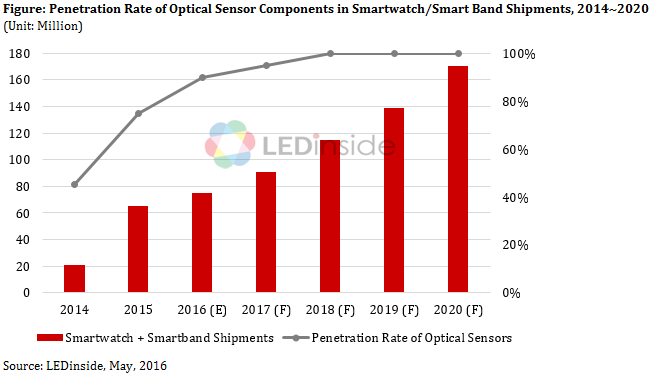The combined shipments of smart watches and smart bands will reach 7.5 million units this year, and 90% of which will be equipped with optical sensor components used for pulse rate monitoring, according to the 2016 UV LED and IR LED Application Markets Report by LEDinside, a division of TrendForce. Shipments of smart watches and smart bands together will total 170 million units by 2020, and all of them are expected to incorporate optical sensor components. A common sensor system that measure pulse rate and blood oxygen concentration is the reflective photoplethymography (PPG) sensor. Due to opportunities in health and fitness trends, the reflective PPG sensor is gradually becoming an integral part of most wearable devices. Additionally, wearable optical sensors that can track pulse rate and other health-related data have huge potential in the home health care market.

oanne Wu, assistant research manager for LED-inside, said PPG is based on an optical sensor technology that uses LED light sources, so it is less susceptible to power supply noise and electromagnetic interference. Compared with other sensor technologies, PPG can take measurements on different parts of a person’s body and can be placed in various positions. Thus, PPG is compatible with wearable designs. Moreover, this optical sensor technology can also detect blood oxygen concentration. In sum, convenience along with wider capability is PPG’s major advantage in the growing home healthcare market.
A reflective PPG sensor uses a green LED for measuring pulse rate, and compares the relative strengths of light from red LED and IR LED to determine blood oxygen concentration. After the processing the signals generated by the reflections of both red and IR LED light, the sensor can calculate the level of oxygen concentration in a person’s blood.
Wu pointed out that there are companies that offer complete solutions for reflective PPG sensors, such as U.S.-based AMS-TAOS, Taiwan’s Pixart Imaging and Lite-on Technology. Their main business model include selling their IC modules and computing software. Their products are available for testing and simulation to further improve accuracy. There are also sensor manufacturers that do not develop their own software but can provide IC modules and partial solutions from their partners in the supply chain.

